 |
| Lavender & Poppies Combine Beautifully |
Easy to Grow Food & Flowers to Plant Now
 |
| Alpine Strawberries add Ground Cover |
- Start with just a few plants, no more than you can plant in one day. Choose your favorite easy-care plant/s, so it’s more of a nurturing experience than a chore to care for them.
- Know your plants: how much sun, water, and room they need, whether they can be grown in containers, what kind of soil is best for them, how much time you’ll need to devote to their care, etc. Look for online advice, or better yet, ask an expert at your local garden center.
- Know where you are going to put your plants before you buy them. Dig the beds and add organic soil amendments, or budget the time to do so, before buying your plants.
- Consider container gardening. Although containers incur a one-time cost and require extra watering and other special care, they’re easy to weed and can be moved as sunlight conditions change during the year. They also beautify your patio and walkways.
- Start with established plants from a knowledgeable farm, nursery, or plant store. In general, growing from seed takes more time, talent, and equipment. Unless they choose easy-to-grow seeds (some listed below), growing from seed can unnecessarily discourage novices.
I recommend starting these plants in May, particularly for
Santa Cruz county and Bay Area residents:
 |
| Two Cherries and Heirlooms in Sunny Zone |
Note: I have had good luck with tomatoes in large
containers, IF I’m able to water them every day in summer when it’s hot,
especially before tomatoes are start turning red. Though tomatoes like full
sun, a dehydrated young tomato plant is likely to be a poor producer regardless
of care later in the season. They generally produce more tomatoes if planted in
the ground.
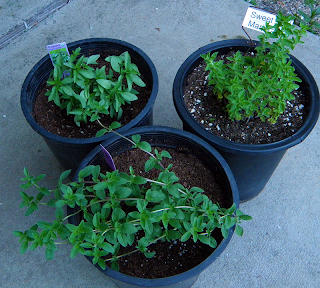 |
| Top 3 Herbs: Thai Basil, Oregano, Marjoram Sweet Italian Basil to Join them Soon! |
3. Leaf Lettuce: Leaf Lettuce grows to
maturity quickly and can be harvested throughout the summer. Try a variety pack
of several kinds of lettuce plants for endless salad combinations. Lettuce is
the first veggie I’d recommend beginners grow from seed. Renee’s Garden has a
large variety of container-friendly lettuces, including ruby and emerald (mixture of red and green leaf), baby butter lettuce, romaine,
and mesclun
(fancy mixed greens). Depending upon your location and choice of lettuce, slugs
may be a problem. Try a container with copper foil. Most leaf lettuces can be grown in containers if given enough room
between plants.
4. Summer Squash:
Most varieties of
summer squash are easy to grow IF you have room enough for them to spread.
Most will produce large quantities that must be faithfully harvested during
peak season to avoid the "7 lb. stuffed-zucchini-for-dinner" syndrome. Though squash is
decidedly not container-friendly, Renee’s Garden has a Container Zucchini that
I’m trying this year. Growing squash from seed is not difficult, and I will let
you know the results of my container experiment.
Young squash plants can appeal to slugs. If slugs like your squash plants, you can build a wall with Slug Off Copper Barrier, or any piece of copper 3 inches high that’s thin enough to bend and surround the plant.
Young squash plants can appeal to slugs. If slugs like your squash plants, you can build a wall with Slug Off Copper Barrier, or any piece of copper 3 inches high that’s thin enough to bend and surround the plant.
A 2-inch wide sprinkling of diatomaceous earth around the perimeter of the plant is another natural remedy for slug-eaten plants; it
abrades slugs’ bodies, so they’ll avoid it. Be aware that you’ll have to
reapply the earth if it rains or washes away with watering. Find diatomaceous
earth with pet or swimming pool filter supplies.
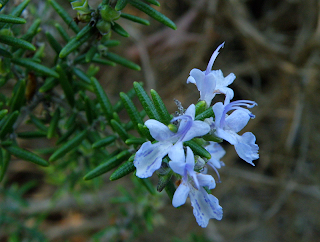 |
| Rosemary Blossoms for Many Months |
Bonus edible: Strawberries: The central coast and Santa Cruz mountains are ideal locations to
grow strawberries,
if you have enough room and sun. The vines spread, crowding out weeds and
providing ground cover. Generally the most productive species require the most
room. Inquire at your garden center about which varieties are best suited to
your mini-habitat. Though I’ve never grown strawberries before, I just
purchased an alpine strawberry, known for small yet delicious fruit. I will let
you know how it goes.
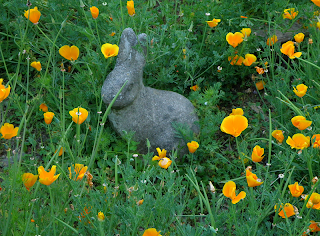 |
| Some Bunny in Nigella and California Poppies |
7. Cosmos: Cosmos
is another showy and drought-tolerant flower. It’s pink to white to purplish and grows to about 3 feet tall, blooming during summer. Renee’s Garden also sells a
knee-high variety. You can grow it readily from seed if you keep it moist until
seedlings are established, with shade cloth or daily watering. This year I’m
experimenting with both seeds and pre-started seedlings.
Seedlings have extensive and delicate roots, so handle plants with care when transplanting to the garden. Water the container and dig appropriate size holes in the garden first. When planting, make an effort not to disturb the integrity of each plant's roots and their surrounding soil. Water after planting, then every day for several days until roots recover from transplant shock. Like the California poppy, cosmos will reseed in following years somewhere in the general area of the original plants. To replant the seeds more formally, collect them when flowers are withered and seeds are dark brown, and plant next year. Cosmos can be used as cut flowers.
Seedlings have extensive and delicate roots, so handle plants with care when transplanting to the garden. Water the container and dig appropriate size holes in the garden first. When planting, make an effort not to disturb the integrity of each plant's roots and their surrounding soil. Water after planting, then every day for several days until roots recover from transplant shock. Like the California poppy, cosmos will reseed in following years somewhere in the general area of the original plants. To replant the seeds more formally, collect them when flowers are withered and seeds are dark brown, and plant next year. Cosmos can be used as cut flowers.
 |
| Newly Planted Mini-Marigolds |
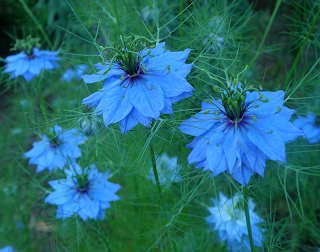 |
| Classic Blue Nigella |
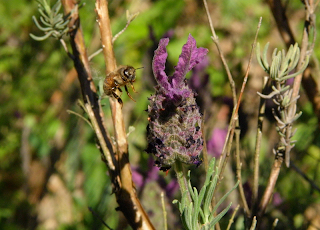 |
| Bees Love Lavender |
Bonus flower: Sunflower:
Showy annual sunflowers
are endemic to the Americas. Many varieties are available, both branched (with
many blossoms) and single-stalked (one large blossom). Most varieties grow to 4
– 6 feet, but dwarf varieties, about 1 foot high, are also available and
appropriate for sunny window boxes. I like growing a variety of sunflowers from
seedlings as an informal border, or along a fence. Children enjoy planting them
because they grow tall relatively quickly. You can also grow them from seed. Birds
as well as humans enjoy the seeds, and sunflowers attract bees. Plus, they are
just so darned cheery and bright!
If I missed any of your favorite easy-to-grow
plants, please leave a comment to tell us about them.
No comments:
Post a Comment